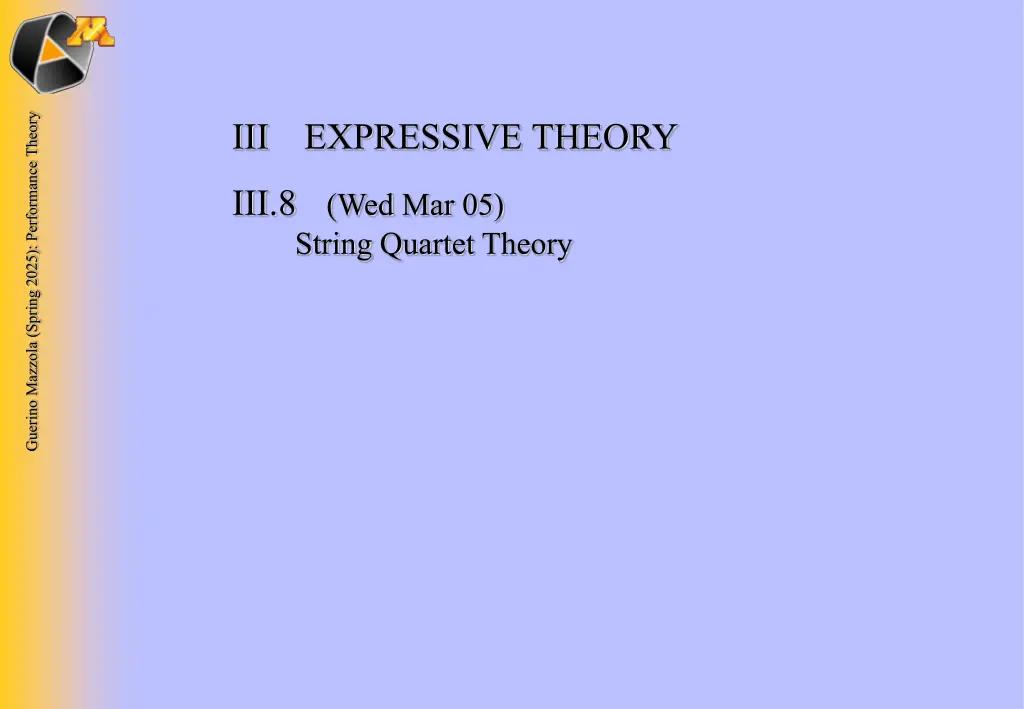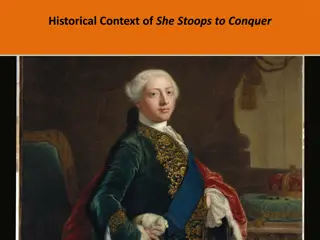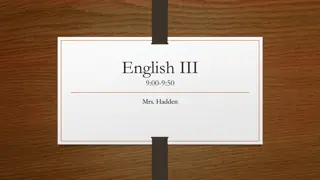
Exploring String Quartet Theory and Development in European Music
Delve into the historical and theoretical prerequisites of string quartet theory, as discussed by Guerino Mazzola and Ludwig Finscher. Discover how the string quartet emerged in the 18th century, its unique development based on creative acts, and the systematic understanding of this instrumental art form. Explore the significance of the four-part texture, the topos of conversation, and the violin family's distinct character in shaping the string quartet as a genre of instrumental music.
Download Presentation

Please find below an Image/Link to download the presentation.
The content on the website is provided AS IS for your information and personal use only. It may not be sold, licensed, or shared on other websites without obtaining consent from the author. If you encounter any issues during the download, it is possible that the publisher has removed the file from their server.
You are allowed to download the files provided on this website for personal or commercial use, subject to the condition that they are used lawfully. All files are the property of their respective owners.
The content on the website is provided AS IS for your information and personal use only. It may not be sold, licensed, or shared on other websites without obtaining consent from the author.
E N D
Presentation Transcript
Guerino Mazzola (Spring 2025): Performance Theory III EXPRESSIVE THEORY III.8 (Wed Mar 05) String Quartet Theory
Guerino Mazzola (Spring 2025): Performance Theory String Quartet Theory: Historical and Theoretical Prerequisites The General Plan The Sound Space of the Violin Family Notes in General Position Performance of the String Quartet
String Quartet Theory: Historical and Theoretical Prerequisites Guerino Mazzola (Spring 2025): Performance Theory The General Plan The Sound Space of the Violin Family Notes in General Position Performance of the String Quartet Ludwig Finscher
Our reference to musicological string quartet theory is Ludwig Finschers habilitation Studien zur Geschichte des Streichquartetts. B renreiter, Kassel 1974. The prehistory of the string quartet is more complicated than that of any other instrumental art form of the eighteenth century. It cannot be causally deduced from any single one of the threads of tradition from where it comes. To a certain degree it is the creative act, the invention out of a moment of the delicate historic equilibrium, the kairos in the sense of ancient Greek thinking. Guerino Mazzola (Spring 2025): Performance Theory The prehistory dates only from about 1720 to 1760 when Luigi Boccherini and Joseph Haydn independently invented the string quartet. In 1761, Boccherini wrote his first quartets in northern Italy, they were published 1767-68 in Paris under the name of quatuor concertant . Probably Haydn had written quartet divertimenti already in the 1750s in Vienna, they were however only well known in 1760. The sparse regional, instrumental, and stylistic rootedness in the string quartet s prehistory, from which this new art form has quite spontaneously emerged, provokes the question whether beyond historical rationales a more systematic understanding could better enlighten the string quartet phenomenon . The problem is to question this precise date (1760) of the rise of this precise instrumental art form (the string quartet) in the context of the European music from the systematic point of view. (G.M.: The Topos of Music, p. 994) > Carl Dahlhaus about history and system
Musicological string quartet theory according to Ludwig Finscher: Das Streichquartett ist die einzige Gattung der neueren Instrumentalmusik, die eine solche an einem einzigen k nstlerischen Modell entwickelte, vergleichsweise genau und detailliert ausformulierte und als allgemeinverbindlich akzeptierte Theorie ausgebildet hat. (L.F. p.279) Guerino Mazzola (Spring 2025): Performance Theory The string quartet is the only genre of more recent instrumental music that has developed a comparably detailed and generally accepted theory built upon a single artistic model. This model is based on the four part texture the topos of a conversation of four humanistically educated persons the distinguished character of the family of violins
the four part texture (G.M.: p. 995) The four part texture was the ideal type of structured polyphony which was oriented on the counterpoint with its long tradition. This is the formal, or better: formalized element of string quartet theory. We have to take it in the full conceptual ambiguity, i.e., on the one hand the texture note against note in its linear temporal progression in the sense of classical counterpoint. On the other, it is a texture of vertical units as an expression of harmonic relations. Guerino Mazzola (Spring 2025): Performance Theory With Haydn one could imagine that he could have added a fifth voice to enrich the texture . But it is reported that he failed on several occasions with this experiment . Ries reports 1838 (L.F. p. 287): Bei der n mlichen Gelegenheit fragte ich Haydn, warum er nie ein Violinquintett geschrieben habe, und erhielt die lakonische Antwort, er habe immer mit vier Stimmen genug gehabt. Man hatte mir n mlich gesagt, es seien drei Quintette von Haydn begehrt worden, die er aber nie h tte komponieren k nnen, weil er sich in den Quartettstil so hineingeschrieben habe, dass er die f nfte Stimme nicht finden k nne; er habe angefangen, es sei aber aus einem Versuche am Ende ein Quartett, aus dem anderen eine Sonate geworden. On the said occasion I asked Haydn why he had never written a violin quintet, and I obtained the laconic answer that he had always had enough with four voices. They had told me that three quintets had been commissioned to Haydn, which he however was never able to compose since he had become so accustomed to the quartet style that he could not find a fifth voice; he had commenced but from one attempt a quartet emerged, and from another a sonata.
the topos of a conversation of four humanistically educated persons (G.M. p. 996) This topos must be cautiously distinguished from the well-known topos of a sound speech , i.e., from the similarity of musical expression or semantics to the common language. In the case of the string quartet, the more important thing than speaking is the dialog, a fact that becomes more evident in the French expression quatuor dialogu for string quartet (in fact the invention of a publisher). The association of a discourse to the string quartet was initiated by the musician Johann Friedrich Reichhardt in 1777 (L.F. p.287): Bei dem Quartett habe ich die Idee eines Gespr chs unter vier Personen gehabt. For the quartet I had the idea of a conversation among four persons. Like Haydn, Reichhardt also views the number of four as being the upper limit for a good dialog. He (also) tries to add a fifth person to the quartet. But he fails: Die f nfte Person ist hier ebensowenig zur Mannigfaltigkeit des Gespr chs nothwendig, als zur Vollstimmigkeit der Harmonie; und in jenem verwirrt sie nur und bringt Undeutlickeiten in s St ck. Here the fifth person is as superfluous for the manifold of the conversation as it is for the full voicedness of harmony; and in the former it only creates confusion and makes the piece cloudy. The same happens to Schumann (L.F. p.289) in a discussion about a viola that was added in a quintet: Man sollte kaum glauben, wie die einzige hinzugekommene Bratsche die Wirkung der Saitenin- strumente auf einmal ver ndert, wie der Charakter des Quintetts ein ganz anderer ist, als der des Quartetts. Hat man im Quartett vier einzelne Menschen geh rt, so glaubt man jetzt eine Versammlung vor sich zu haben. It is incredible how a single added viola alters the effect of the string instruments, changing the character of the quintet radically as opposed to the quartet. If you heard four single persons in the quartet, you believe that now, you are facing an assembly. Guerino Mazzola (Spring 2025): Performance Theory
the distinguished character of the family of violins (G.M. p. 997) The formation of the string quartet would not have been thinkable without the collaboration of the homogeneous sound of the instruments of the violin family. Finscher describes (L.F. p.124/125) the characteristic of violins as compared to the gambas, which were the preferred solo instruments in the seventeenth century, as follows: Die Violinen hatten gegen ber den Gamben jedoch noch eine weitere zukunftstr chtige Eigenart: Sie gliederten den Tonraum, der ehemals in Analogie zu den menschlichen Stimmengattungen gebildet, nun aber in der Tiefe wie in der H he l ngst kr ftig erweitert worden war, klarer und sinnf lliger, mit deutlicherer Individualisierung ihrer jeweiligen Tonbereiche. (...) F r das klassische Streichquartett, das die Beweglichkeit, den Lagenwechsel, den Kontrast- und Farbreichtum des symphonischen Streichersatzes mit der gr sstm glichen Ann herung an eine streng auskomponierte Vierstimmigkeit zu verbinden suchte, bot sich das vierstimmige Ensemble aus Gliedern der Violinfamilie als das ideale Instrument an. Compared to the gambas the violins had a further seminal peculiarity: They articulated the sound space, which originally was built in analogy to the human voices, now being however strongly extended in low and high pitches, with more clarity and evidence, with pronounced individualization of the respective regions of sound. (...) For the classical string quartet, which attempted to ideally connect flexibility, change of position, richness of contrast and colors of a symphonic string setting to the optimal approximation of a complete four voice setting, the ensemble built from the four instruments of the violin family offered the ideal instrument. Guerino Mazzola (Spring 2025): Performance Theory
Guerino Mazzola (Spring 2025): Performance Theory String Quartet Theory: Historical and Theoretical Prerequisites The General Plan The Sound Space of the Violin Family Notes in General Position Performance of the String Quartet
The general plan is to realize a performance of the given string quartet composition, such that the sound events associated with the notes are in positions that make them as independent from each other as possible. Such a construction is called a resolution of the composition. Guerino Mazzola (Spring 2025): Performance Theory Intuitively this means that one may look at these sound events from most perspectives and still recognize their relations. Remember just tuning! Octave, fifth, third independent. platonic bodies So the idea is to find a performance such the groups of sound events, which are important, stay in general position, i.e., as independent as possible.
four musical examples from performance! 1 dynamics L.v.B. op. 106/Allegro/m.253 f +10 dB l f l Guerino Mazzola (Spring 2025): Performance Theory f -5 dB e e special position: line general position: triangle 2 articulation L.v.B. op. 106/Allegro/m.253 d d 1/8 1/8 e e special position: line general position: triangle
3 combination of dynamics and articulation Guerino Mazzola (Spring 2025): Performance Theory L.v.B. op. 106/Allegro/m.253 h h h e e e special position: line l l d less special position: quadrangle general position: tetrahedron
4 tempo ritardando Guerino Mazzola (Spring 2025): Performance Theory d e e special position: line general position: triangle
Guerino Mazzola (Spring 2025): Performance Theory Strategy: 1. Find out how many notes in general position can be played by an orchestra composed from the violin family! 2. Find out how many notes in general positions are required to express note assemblies of counterpoint and harmony of the 18th Century!
Guerino Mazzola (Spring 2025): Performance Theory String Quartet Theory: Historical and Theoretical Prerequisites The General Plan The Sound Space of the Violin Family Notes in General Position Performance of the String Quartet
Guerino Mazzola (Spring 2025): Performance Theory Sound parameters for the violin family instruments
Sound parameters for the violin family instruments (all parameters in real number spaces) A. geometric parameters: Guerino Mazzola (Spring 2025): Performance Theory 1. onset, duration, pitch, = 3-dim. space G (loudness will be added via amplitude to the technical parameters) duration B. sound color parameters: pitch 1. instrumental parameters: violin type, choice of strings, performance conditions onset 2. global technical parameters: vibrato: delay/ pitch modulation (range of finger movement)/ modulation frequency/ amplitude modulation (contact point of finger tip) SEE! bow angle, bow contact point they are a strong function of the individual player 3. local technical parameters: bow pressure, bow velocity = 2-dim. space H they can be steered quickly and independently of each other, bow pressure amplitude.
The instrumental and global color parameter vector for violins is much more variable between individual players/instruments than for most other instruments, such as horns Guarneri Guerino Mazzola (Spring 2025): Performance Theory F-horn
Guerino Mazzola (Spring 2025): Performance Theory String Quartet Theory: Historical and Theoretical Prerequisites The General Plan The Sound Space of the Violin Family Notes in General Position Performance of the String Quartet
The violins 1, 2,... n offer this configuration space for their parameters: the individual vectors v1, v2, v3, ... vnwith independent directions in the instrumental and global color parameter space the 2-space H of local technical parameters (bow pressure, bow velocity) the 3-space G of geometric parameters (onset, duration, pitch) Guerino Mazzola (Spring 2025): Performance Theory vn v4 v3 v2 v1 Theorem: We can position at most n + 5 notes in general position in the parameter space of n violins
Guerino Mazzola (Spring 2025): Performance Theory String Quartet Theory: Historical and Theoretical Prerequisites The General Plan The Sound Space of the Violin Family Notes in General Position Performance of the String Quartet
How many notes do we maximally need to express counterpoint and harmony of the late 18th Century? Guerino Mazzola (Spring 2025): Performance Theory 1. Counterpoint: essentially two successive intervals, sometimes three to view hidden parallels of fifths, i.e. 6 notes in one chart Tittel, The New Gradus, p.12 2. Harmony: cadences and modulations, essentially three successive triads, such as IVC, VC, ICfor a cadence of tonality C, or IVC, IIF, IF for a modulation scheme, i.e., 9 notes in one chart Schoenberg, Harmony, p. 197
We therefore need at most 9 notes in an assembly of notes that should be represented in general position. Guerino Mazzola (Spring 2025): Performance Theory But we have that theorem which tells us 9 n + 5 which means 4 n We need at least 4 violins to position those 9 notes in general position in order to represent the essentials of the contrapuntal and harmonic thinking in the late 18th Century. So with 4 violins we are ok, more is not necessary, although of course not forbidden. But 4 suffices. I argue that this is the deeper reason, why Haydn, Schumann and others did not need a fifth voice in these string compositions.






















